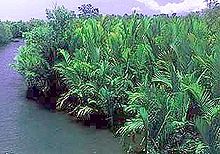- Nypa fruticans
-
Nypa fruticans
Temporal range: 70 Ma Late Cretaceous - Recent
Nipa palms along a tidal river
at Maitum, Sarangani, PhilippinesScientific classification Kingdom: Plantae (unranked): Angiosperms (unranked): Monocots (unranked): Commelinids Order: Arecales Family: Arecaceae Subfamily: Nypoideae Genus: Nypa
SteckSpecies: N. fruticans Binomial name Nypa fruticans
WurmbNypa fruticans, known as the attap palm (Singapore), nipa palm (Philippines), and mangrove palm or buah atap (Indonesia), buah nipah (Malaysia), dừa nước (Vietnam), Ging Pol in Sinhala in Sri Lanka and gol pata (Bangladesh), dani (Burma). It is the only palm considered a mangrove in the Mangroves Biome. This species is a monotypic taxon, the only one in the genus Nypa, grows in southern Asia and northern Australia within the Indomalaya ecozone.
Contents
Distribution
Nypa fruticans, Nipa palms, grow in soft mud and slow moving tidal and river waters that bring in nutrients. The palm can be found as far inland as the tide can deposit the floating nuts. It is common on coasts and rivers flowing into the Indian and Pacific Oceans, from Bangladesh to the Pacific Islands. The plant will survive occasional short term drying of its environment.
Description
Nypa fruticans, the Nipa palm, has a horizontal trunk that grows beneath the ground and only the leaves and flower stalk grow upwards above the surface. Thus, it is an unusual tree, and the leaves can extend up to 9 m (30 ft) in height. The flowers are a globular inflorescence of female flowers at the tip with catkin-like red or yellow male flowers on the lower branches. The flower yields a woody nut, these arranged in a cluster compressed into a ball up to 25 cm (10 in) across on a single stalk. The ripe nuts separate from the ball and are floated away on the tide, occasionally germinating while still water-borne.
Uses
The long, feathery leaves of the Nipa palm are used by local populations as roof material for thatched houses or dwellings. The leaves are also used in many types of basketry and thatching. Large stems are used to train swimming in Burma as it has buoyancy.
On the islands of Roti and Savu, Nipah sap is fed to pigs during the dry season. This is said to impart a sweet flavour to the meat. The young leaves are used to wrap tobacco for smoking.
Food and beverages
In the Philippines and Malaysia, the flower cluster (inflorescence) can be tapped before it blooms to yield a sweet, edible sap collected to produce a local alcoholic beverage called tuba, bahal or tuak. Tuba can be stored in tapayan (balloon vases) for several weeks to make a kind of vinegar known as sukang paombong in the Philippines and cuka nipah in Malaysia. Tuba can also be distilled to make arrack, locally known as lambanog in Filipino and arak in Indonesian.
Young shoots are also edible and the flower petals can be infused to make an aromatic tisane. Attap chee (Chinese: 亞答子; pinyin: yà dá zǐ) ("chee" meaning "seed" in several Chinese dialects) is a name for the immature fruits—sweet, translucent, gelatinous balls used as a dessert ingredient in Thailand, Malaysia and Singapore.
Biofuel
Nipah has a very high sugar-rich sap yield(NIRA). Fermented into Etanol/Butanol the palm's large amount of sap may allow for the production of 6,480-15,600 liters (per year) of Ethanol/Butanol per hectare. Sugarcane yields 5,000–8,000 liters per hectare(per year) and an equivalent area planted in corn would produce just 2000 liters(per year)per hectare.
Pre-history
Fossil mangrove palm pollen has been dated to 70 million years ago. Fossilized nuts of Nypa dating to the Eocene epoch occur in the sandbeds of Branksome, Dorset, and in London Clay on the Isle of Sheppey, Kent,[1] testifying to much warmer climatic conditions in the British Isles at that time.
Endangered species
Nypa fruticans is an endangered species in Singapore.
References
Categories:- Palms
- Flora of Indochina
- Flora of Malesia
- Flora of the Philippines
- Flora of Thailand
- Flora of Vietnam
- Flora of Singapore
- Flora of Indonesia
- Flora of Malaysia
- Flora of Australia
- Flora of Borneo
- Flora of Papua New Guinea
- Flora of Cambodia
- Flora of Burma
- Flora of Bangladesh
- Vietnamese ingredients
- Edible plants
- Tropical fruit
- Endangered plants
- Mangroves
Wikimedia Foundation. 2010.




